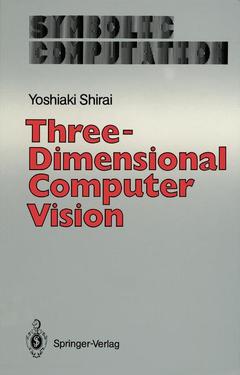Description
Three-Dimensional Computer Vision, Softcover reprint of the original 1st ed. 1987
Coll. Computer Graphics - Systems and Applications
Language: French
Subject for Three-Dimensional Computer Vision:
Publication date: 01-2012
298 p. · 17x24.4 cm · Paperback
298 p. · 17x24.4 cm · Paperback
Description
/li>Contents
/li>
The purpose of computer vision is to make computers capable of understanding environments from visual information. Computer vision has been an interesting theme in the field of artificial intelligence. It involves a variety of intelligent information processing: both pattern processing for extraction of meaningful symbols from visual information and symbol processing for determining what the symbols represent. The term "3D computer vision" is used if visual information has to be interpreted as three-dimensional scenes. 3D computer vision is more challenging because objects are seen from limited directions and some objects are occluded by others. In 1980, the author wrote a book "Computer Vision" in Japanese to introduce an interesting new approach to visual information processing developed so far. Since then computer vision has made remarkable progress: various rangefinders have become available, new methods have been developed to obtain 3D informa tion, knowledge representation frameworks have been proposed, geometric models which were developed in CAD/CAM have been used for computer vision, and so on. The progress in computer vision technology has made it possible to understand more complex 3 D scenes. There is an increasing demand for 3D computer vision. In factories, for example, automatic assembly and inspection can be realized with fewer con straints than conventional ones which employ two-dimensional computer vision.
1 Introduction.- 1.1 Three-Dimensional Computer Vision.- 1.2 Related Fields.- 1.3 Mainstream of 3D Computer Vision Research.- 2 Image Input.- 2.1 Imaging Geometry.- 2.2 Image Input Devices.- 2.3 Color.- 2.4 Color Input.- 2.5 Range.- 2.6 Moiré Topography.- 2.7 Preprocessing.- 3 Image Feature Extraction.- 3.1 Edge Point Detection.- 3.2 Local Edge Linking.- 3.3 Edge Point Clustering in Parameter Space.- 3.4 Edge-Following Methods.- 3.5 Region Methods.- 4 Image Feature Description.- 4.1 Representation of Lines.- 4.2 Segmentation of a Sequence of Points.- 4.3 Fitting Line Equations.- 4.4 Conversion Between Lines and Regions.- 5 Interpretation of Line Drawings.- 5.1 Roberts’ Matching Method.- 5.2 Decomposition of Line Drawings Into Objects.- 5.3 Labeling Line Drawings.- 5.4 Further Problems in Line Drawing Interpretation.- 6 Realizability of Line Drawings.- 6.1 Line Drawings Without Interpretations.- 6.2 Use of Gradient Space.- 6.3 Use of Linear Equation Systems.- 7 Stereo Vision.- 7.1 Stereo Image Geometry.- 7.2 Area-Based Stereo.- 7.3 Feature-Based Stereo.- 8 Shape from Monocular Images.- 8.1 Shape from Shading.- 8.2 Use of Polarized Light.- 8.3 Shape from Geometrical Constraint on Scene.- 9 Range Data Processing.- 9.1 Range Data.- 9.2 Edge Point Detection Along a Stripe Image.- 9.3 Two-Dimensional Edge Operators for Range Images.- 9.4 Scene Segmentation Based on Stripe Image Analysis.- 9.5 Linking Three-Dimensional Edges.- 9.6 Three-Dimensional Region Growing.- 10 Three-Dimensional Description and Representation.- 10.1 Three-Dimensional Curves.- 10.2 Surfaces.- 10.3 Interpolation of Serial Sections with Surface Patches.- 10.4 Generalized Cylinders.- 10.5 Geometric Models.- 10.6 Extended Gaussian Image.- 11 Knowledge Representation and Use.- 11.1 Types of Knowledge.-11.2 Knowledge Representation.- 12 Image Analysis Using Knowledge About Scenes.- 12.1 Analysis of Intensity Images Using Knowledge About Polyhedral Objects.- 12.2 Analysis of Range Images with the Aid of a Junction Dictionary.- 13 Image Understanding Using Two-Dimensional Models.- 13.1 Recognition of Isolated Curved Objects Using a Graph Model.- 13.2 Interpretation of Imperfect Regions Using a Scene Model.- 13.3 Recognition of Multiple Objects Using 2D Object Models.- 14 Image Understanding Using Three-Dimensional Models.- 14.1 Matching for Verification Vision.- 14.2 Object Recognition by Predicting Image Features from Models.- 14.3 Matching Geometric Models to the Description of a Single Object.- 14.4 Recognition of Multiple Objects After Segmentation.- 14.5 Recognition Without Segmentation.- References.
© 2024 LAVOISIER S.A.S.

